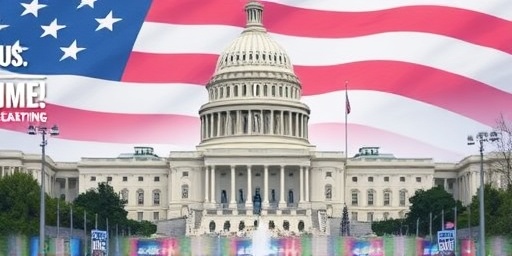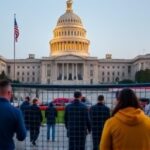As the U.S. Government shutdown stretches into its 34th day, federal employees are lining up for food assistance while airports grapple with unprecedented delays, painting a stark picture of a nation paralyzed by political impasse. The ongoing stalemate in Congress has halted essential federal services, inflicting growing wounds on the economy and everyday life across the USA.
- Federal Workers Grapple with Unpaid Wages and Food Insecurity
- Airport Mayhem and Travel Disruptions Cripple National Mobility
- Congressional Stalemate Deepens: Budget Battles and Partisan Rifts
- Economic Fallout Spreads: From Wall Street to Main Street
- Path to Resolution? Experts Outline Recovery Hurdles and Long-Term Reforms
Federal Workers Grapple with Unpaid Wages and Food Insecurity
The human cost of the Government shutdown is becoming increasingly visible, with over 800,000 federal workers furloughed or working without pay. In Washington D.C. alone, long lines have formed at food banks and community centers, where civil servants who once managed national programs now seek basic necessities. According to a report from the U.S. Conference of Mayors, food insecurity among federal employees has surged by 40% in the past month, exacerbating the strain on local resources.
“I’ve never imagined I’d be here, waiting in line for a meal,” said Maria Gonzalez, a 15-year veteran of the Department of Homeland Security, speaking to reporters outside a D.C. pantry. “We’re the ones who keep the country running, and now we’re the ones falling through the cracks.” Gonzalez’s story echoes thousands more, as the shutdown disrupts not just paychecks but also access to health benefits and retirement contributions.
Economists warn that this ripple effect is hitting the broader economy hard. The Congressional Budget Office estimates that the shutdown could cost the U.S. up to $8 billion per week in lost productivity, with federal workers’ reduced spending alone subtracting $1.5 billion monthly from consumer markets. Small businesses near federal installations, from Virginia’s defense contractors to Colorado’s park vendors, report sales drops of up to 60%, forcing layoffs and closures.
- Key Statistics on Worker Impact:
- 800,000+ furloughed employees nationwide
- 2.1 million contractors also unpaid
- Estimated $18 billion total economic loss so far
- 25% increase in unemployment claims from federal regions
Without intervention, experts predict a “shutdown hangover” where workers delay big purchases, further dampening growth in an already fragile post-pandemic recovery.
Airport Mayhem and Travel Disruptions Cripple National Mobility
Air travel across the USA has descended into chaos as the Government shutdown slashes staffing at the Transportation Security Administration (TSA) and Federal Aviation Administration (FAA). Major hubs like Atlanta’s Hartsfield-Jackson and New York’s JFK have seen wait times balloon to over three hours, leading to thousands of missed flights and frustrated passengers.
The FAA reports a 30% reduction in air traffic controllers on duty, resulting in widespread ground stops and rerouting. “This isn’t just inconvenience; it’s a safety risk,” noted aviation analyst Sarah Kline from the Brookings Institution. “Understaffed towers mean slower responses to emergencies, and we’re already seeing near-misses up 15% compared to last year.”
Beyond airports, the shutdown is grounding other federal services. Amtrak delays have piled up due to unmaintained tracks, and border crossings at ports like San Diego are bottlenecked, delaying commercial shipments worth billions. A coalition of business groups, including the U.S. Chamber of Commerce, has urged Congress to act, estimating $300 million daily in trade losses.
- Daily Disruptions: 1,200+ flights delayed or canceled
- Passenger Complaints: Surge of 500% in TSA grievance filings
- Business Fallout: Airlines report $50 million weekly revenue hit
- Safety Concerns: FAA whistleblowers highlight fatigue among remaining staff
Travelers like businessman Tom Reilly, stranded in Chicago, shared his ordeal: “I lost a major client because I couldn’t make the meeting. This shutdown isn’t just government business—it’s everyone’s problem.” As holiday travel peaks, the pressure mounts on lawmakers to resolve the impasse before the situation spirals further.
Congressional Stalemate Deepens: Budget Battles and Partisan Rifts
At the heart of the government shutdown lies a bitter divide in Congress, where negotiations over spending bills have stalled for weeks. The core dispute revolves around funding for border security, with Republicans demanding $5 billion for a southern wall and Democrats insisting on protections for Dreamers and increased humanitarian aid. House Speaker Nancy Pelosi has called the Republican proposal “unacceptable,” while Senate Majority Leader Mitch McConnell blocks votes without presidential approval.
President Trump’s recent tweetstorm accused Democrats of “holding the country hostage,” but White House sources reveal internal frustrations as veto threats loom. Bipartisan talks, mediated by Senate moderates like Susan Collins and Joe Manchin, collapsed last week after a 12-hour session yielded no compromise.
“We’ve seen this movie before, but this time the stakes are higher,” commented political analyst David Axelrod on CNN. “The USA‘s global reputation is taking a hit, with allies questioning our stability amid fiscal gridlock.” International markets have reacted warily, with the Dow Jones dipping 2% in the past week on shutdown fears.
Behind the scenes, lobbying intensifies. Tech giants like Amazon push for restored IRS funding to process tax refunds, while environmental groups rally against cuts to the EPA. A recent Gallup poll shows 65% of Americans blame both parties equally, with approval ratings for Congress plummeting to 18%.
Economic Fallout Spreads: From Wall Street to Main Street
The economy is feeling the shutdown’s pinch far beyond federal borders, with GDP growth projections slashed by 0.5% for the quarter. Moody’s Analytics forecasts a potential recession trigger if the impasse lasts beyond 45 days, citing halted research grants, delayed infrastructure projects, and frozen Small Business Administration loans.
In the heartland, farmers in Iowa and manufacturers in Michigan decry unpaid subsidies and export delays. The USDA’s suspension of crop insurance inspections has left 100,000+ farms vulnerable, prompting emergency aid requests from state governors. “Our rural economy can’t afford this,” said Kansas Governor Laura Kelly in a joint statement with Midwestern leaders.
Wall Street mirrors the unease: Bond yields have risen as investors flee to safe havens, and the dollar has weakened against the euro by 1.2%. Retail sectors report a 10% drop in holiday sales forecasts, with chains like Walmart attributing slowdowns to cautious federal worker spending.
- Sector-Specific Hits:
- Defense: $11 billion in contracts paused
- Healthcare: NIH trials delayed, affecting 50,000 patients
- Education: Student loan processing halted for 200,000 applicants
- Energy: Offshore drilling permits frozen, costing $2 billion
Nonprofits and veterans’ groups are stepping in where federal services falter, but donations can’t fill the void. The Wounded Warrior Project has seen a 20% uptick in calls for assistance, highlighting the shutdown’s toll on military families.
Path to Resolution? Experts Outline Recovery Hurdles and Long-Term Reforms
As the government shutdown drags on, eyes turn to potential breakthroughs. A slim majority in the House favors a clean continuing resolution to reopen agencies through March, but Senate hurdles remain. Vice President Kamala Harris is reportedly scheduling closed-door meetings with key senators, aiming for a deal by week’s end.
Yet, even if resolved, the aftermath looms large. The Treasury Department warns of a $20 billion backpay bill, straining the budget deficit already at $3 trillion. Economists like Mark Zandi from Moody’s predict a slow rebound, with consumer confidence lagging for months. “This shutdown erodes trust in institutions,” Zandi said. “Rebuilding that will take more than a vote— it needs structural fixes to prevent future crises.”
Looking ahead, calls for reform intensify. Bipartisan bills propose automatic shutdown extensions and debt ceiling adjustments, but passage seems unlikely in the polarized climate. For the USA, the shutdown serves as a wake-up call: In a divided Congress, the cost of inaction falls heaviest on the most vulnerable. As negotiations resume, the nation holds its breath, hoping for stability before the economic scars deepen further.
Stakeholders from labor unions to corporate boards urge swift action, emphasizing that prolonged disruption threatens not just federal services but the foundational pillars of American prosperity. The coming days will test whether lawmakers can bridge the divide, or if the shutdown’s legacy will be one of lasting division and delay.









